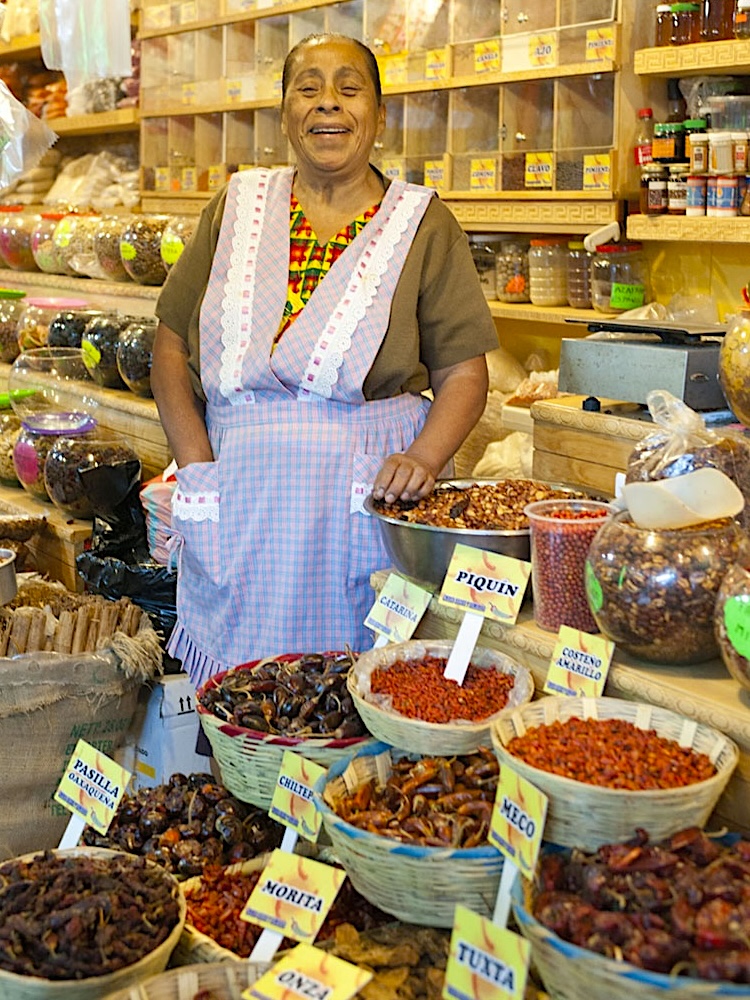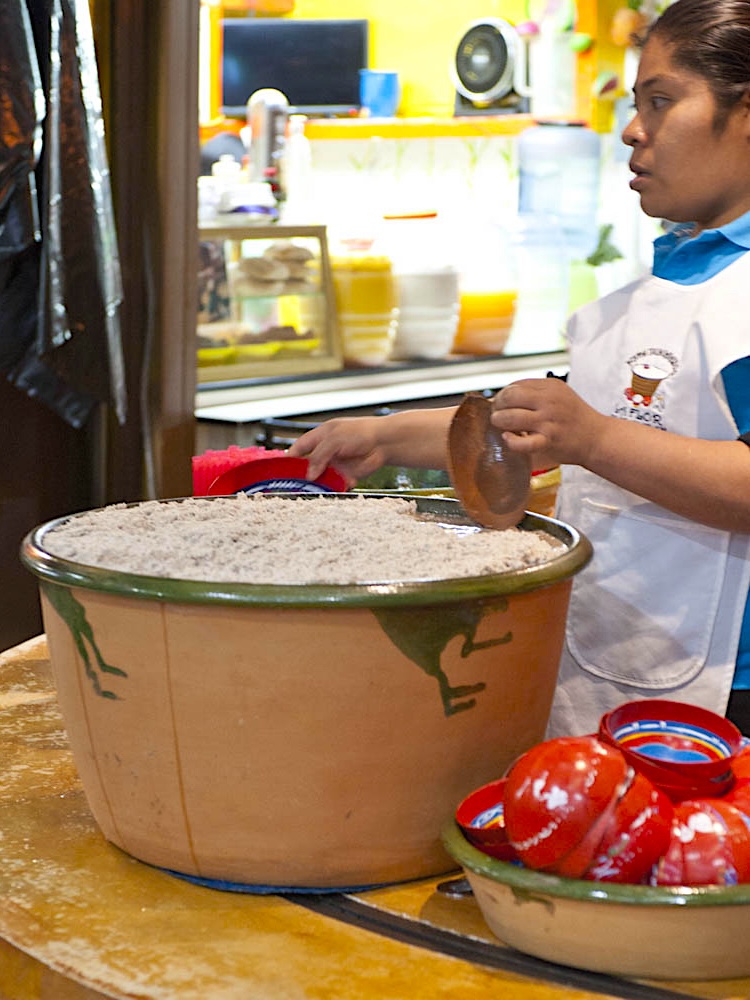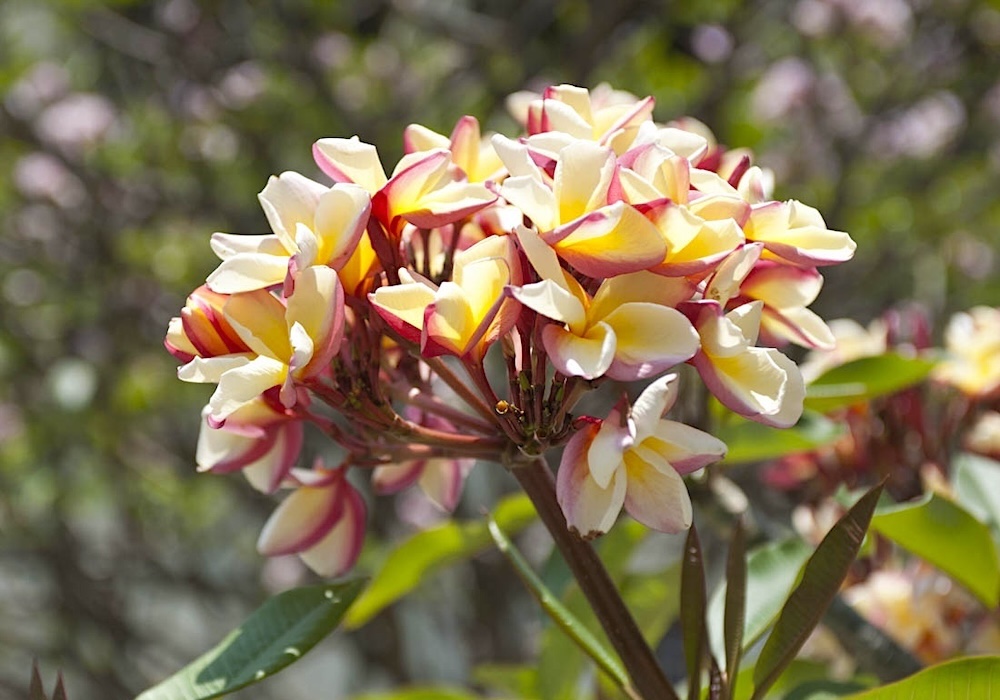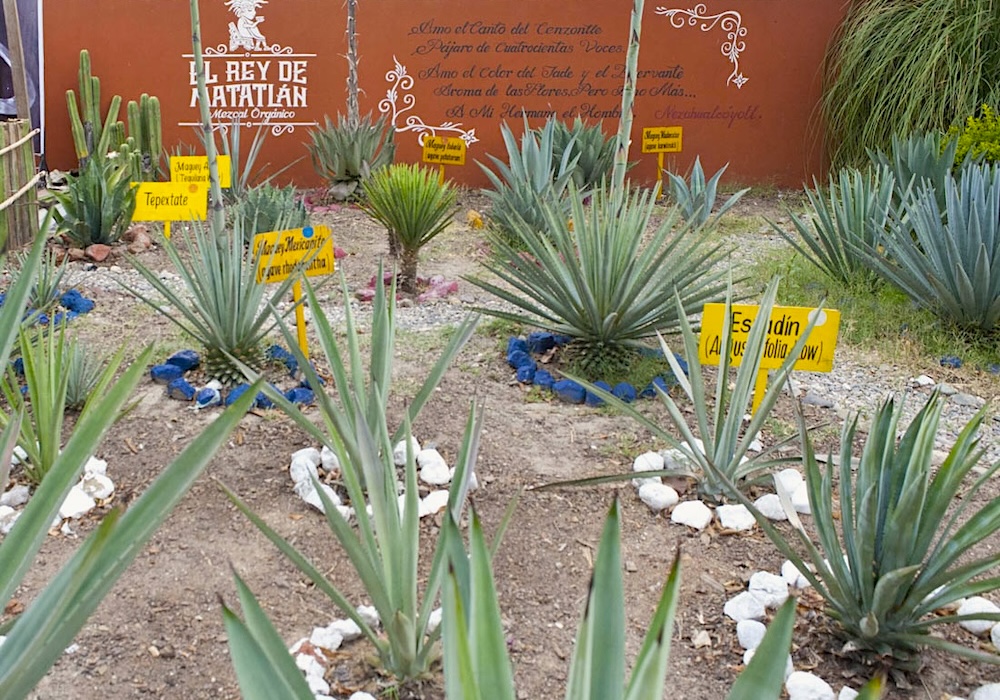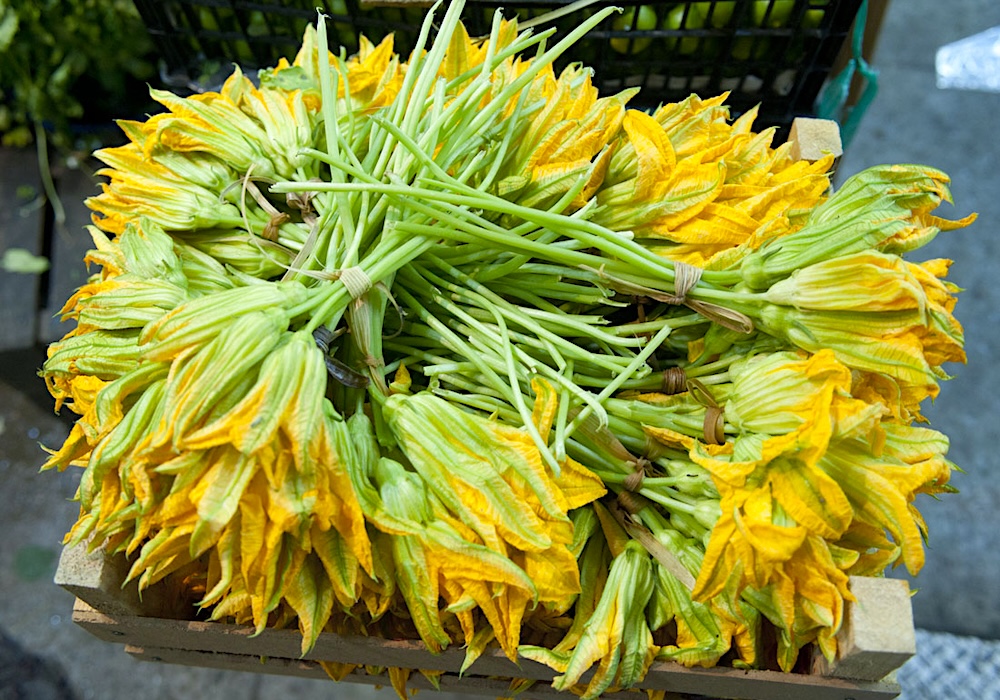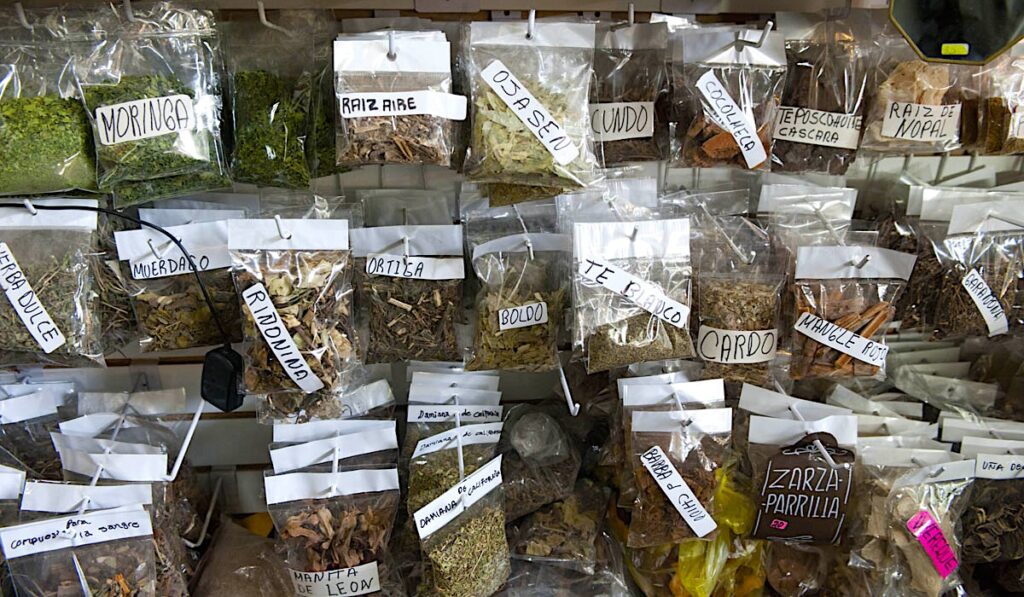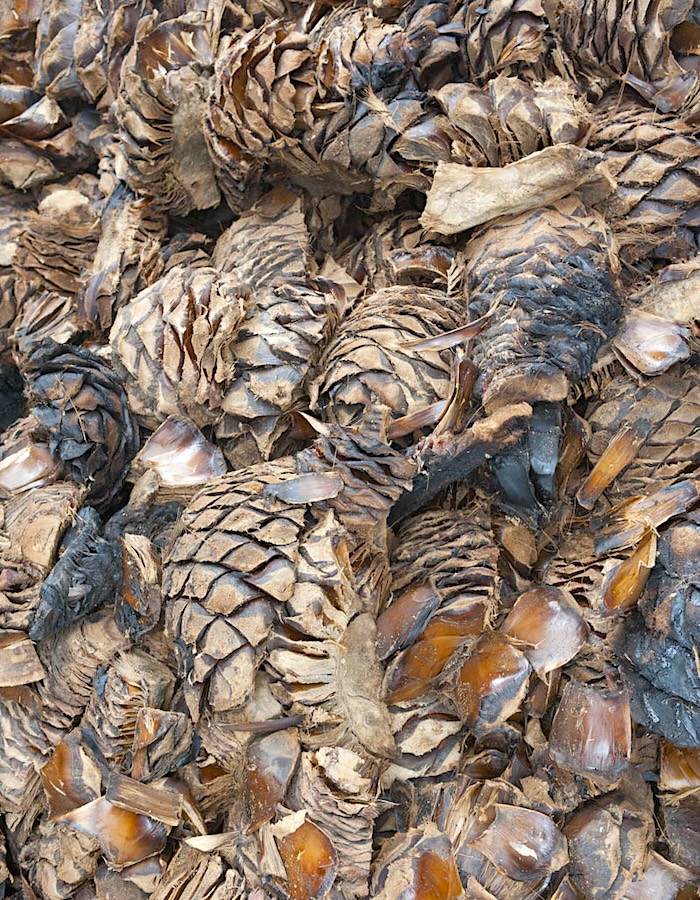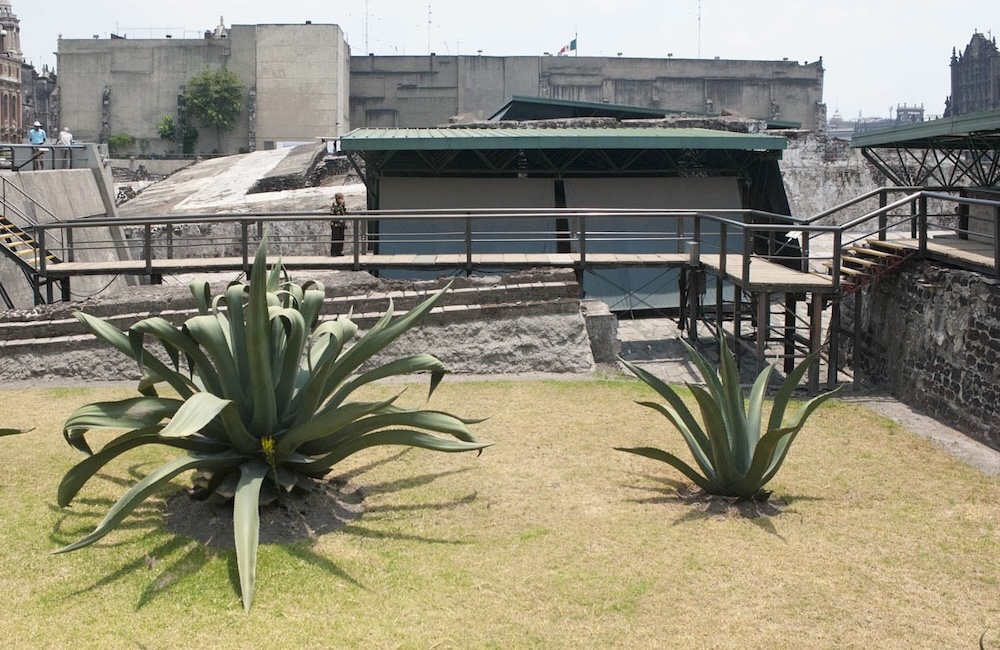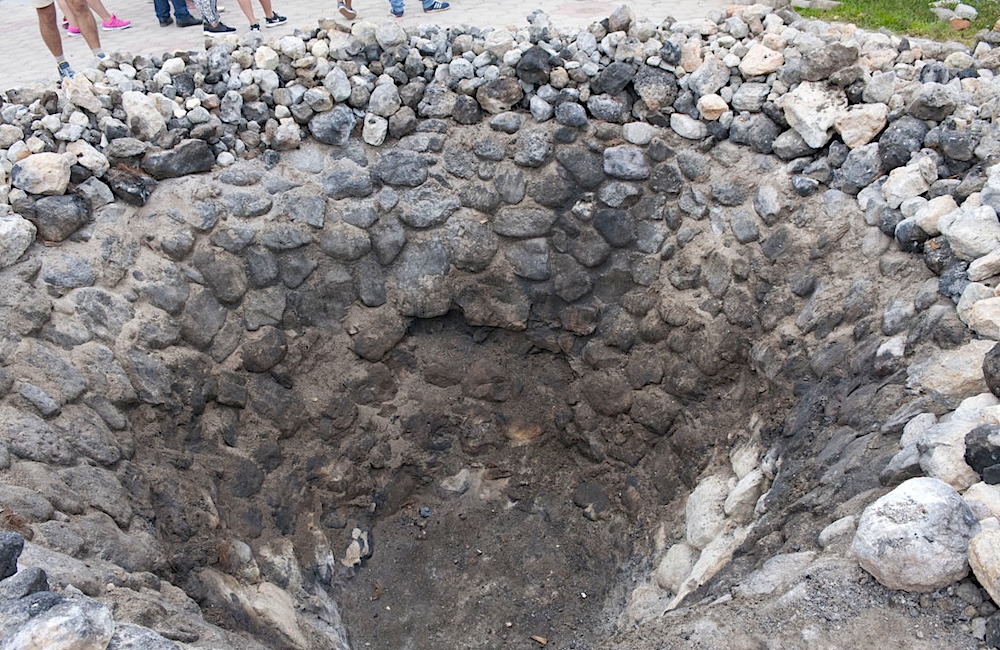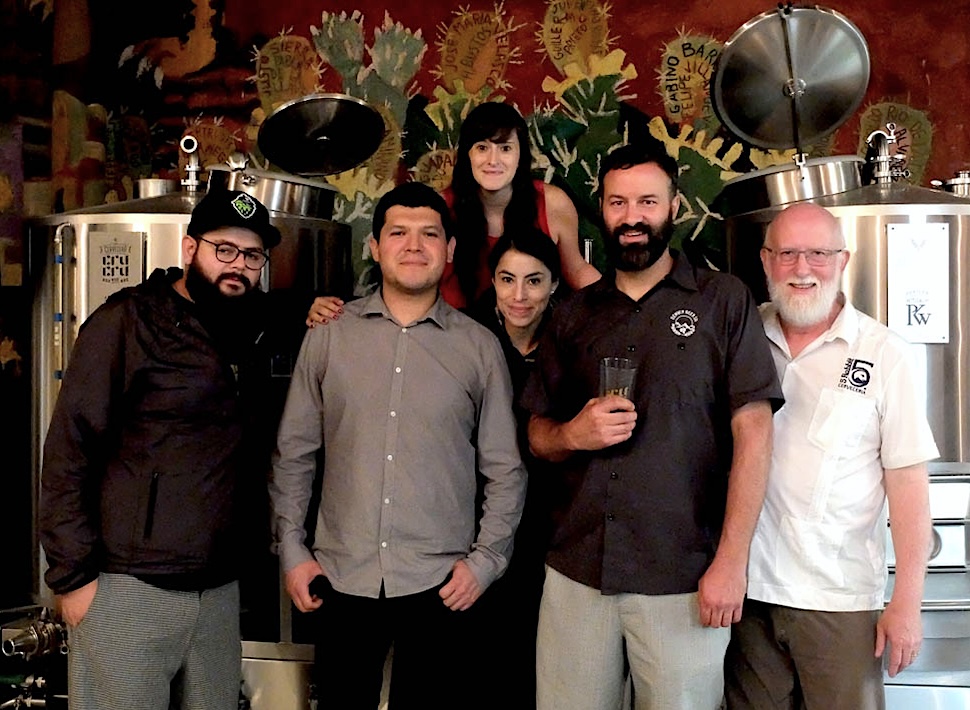© 2017, Randy Mosher
Above: Our group (Lucía, Jason and myself on the right) with the crew from Cru-Cru: Luis, his brewer Armando, and wife Rebeca.
Oaxaca and Mexico City
In Mexico you don’t have to look very far to discover a panorama of exciting flavors! Much of the food there remains fiercely local and always shows a particular point of view. The photos accompanying this article show a few interesting aspects of my 2017 trip to Oaxaca and Mexico City, as well as a separate beer trip to Puebla and Cholula.
The main Oaxaca City Mercado is manageable in size and has a little bit of everything. This lady (first photo in gallery at bottom of page) was presiding over a spice shop called “Almita,” featuring a wide variety of chiles, spices and herbs, mostly focused on culinary items.
Along with some local chiles, I bought a few interesting flowers from her. First was rosita de cacao (Quareribea funebris), an intensely aromatic seasoning commonly used in cacao beverages in Oaxaca and elswhere in the region. It’s hard to describe, with a penetrating, slightly musky aroma perhaps along the lines of a vegetative truffle. It is not, as sometimes described, the flowers of the cacao tree, whose flowers are tiny and not particularly aromatic.
The second flower is called flor de mayo, a perfumy tree-blossom from a very decorative tree that was bred since early times in Oaxaca for its gorgeous and highly aromatic flowers. It has become an important flower in the perfume industry, under the name of frangipani and mostly cultivated in India and elsewhere. The aroma is sweet, slightly fruity and quite persistant.
The third flower is called “heart flower” (Talauma mexicana). Like the others, it is used in cacao, adding what is usually described as a “sweet aroma.” The batch I have is quite robust and thick rather than being what you would think of as flower petals. In whole dried form it’s not very aromatic, when ground and extracted with vodka it’s quite fruity, with a hint of sweet spoiciness and some barky tannin on the palate—perhaps substitued by cinnamon in colonial days.
These things had been on my list for quite a while, so it’s exciting to come face-to-face with them. It will be interesting to see how these find their ways into beers.
Tejate is a very traditional cacao beverage, always served cold. It uses cacao beans, alkaline-processed corn (nixtamal; in the US we know it as hominy), water, sugar and seasonings, which may include cinnamon, mamey pits, rosita de cacao and some of the other seasonings discussed here.
It is invariably made by women, and everyone has their own special recipe. A dense layer of persuistent foam is an important feature contributed by certain ingredients and vigorous whipping. It is traditionally served in decorated calabashes.
The taste is light and slightly sweet; definitely chocolatey, but amazingly layered, with spice, the bitter almond of mamey pit and the indifinable character of rosita de cacao. It’s quite refreshing as well—an attribute we don’t often associate with cacao.
Most of the herbs shown here are for medicinal purposes, but the one labeled “Manita de Leon” is a tree flower sometimes used to flavor traditional cacao beverages—in addition to its medicinal qualities.
Of course there are chiles. In addition to better-known varieties, specifically chilhuacle and chilcostle, are specifically Oaxacan and used in mole and other dishes.
We toured the Jardin Etnobotánico with its founder/director Alejandro de Ávila. It’s a lovely place and laid out to showcase the interaction between plants and human culture. Corn and many other important plants were domesticated thousands of years ago. Each has its own fascinating story, and of course, we barely scratched the surface.
While the distilled spirit mezcal is made in several Mexican states, Oaxaca is by far the most important region for it. It may be made from dozens of different types of agave. In Oaxaca alone, 25 species are used, but the primary cultivated variety is called Espadín. A few of the Oaxacan species are shown in the photo below of the demonstration garden at Mezcalería El Rey del Matatlán, about half an hour east of Oaxaca City in the heart of mezcal country.
Mezcal is a deliciously complex spirit, combining fruitiness, a pleasant vegetal/cactus character (you may recognize this from tequila, which is technically a form of mezcal), with perhaps a hint of spice and most often an obvious smoky character on top of it all.
Mezcal is fermented from roasted agave hearts like the ones pictured below, traditionally cooked for several days in wood-fired roasting pits like the one also shown below. In contrast, the rules for tequila specify steam cooking, which produces a less complex flavor.
While there are some large producers, mezcal is an incredibly artisanal spirit. Using very simple technologies, traditional producers in villages make mezcals that reflect the conditions and available resources of the land. Ancient techniques such as clay stills, fermentation in raw cowhide and the practice of hanging a cooked chicken in the still (“pechuga” on the label) still exist. For the time being, mezcal is still very much a family business, especially in the more remote villages, and one can still find family members selling the products of their palanque, or production shed.
Over the two trips we tried mezcal from several varieties of agave, including those normally used for tequila and pulque, plus mezcals flavored with mole spices, mezcal with medicinal herbs like copal, mezcal with worm, and pechuga versions made with lamb and ostrich, along with reposado and añejo versions. In the end, my opinion is that pure mezcal is perfection itself, and that any attempt to elaborate upon it only screws it up.
Most mezcal lovers prefer the unadulterated joven (young, and also white) form. A seasoned salt made from ground roasted worms, salt and sometimes a little chile is often served as an accompaniment. While that’s quite nice, what I really like it with is chocolate.
We did find a lot of well-informed enthusiasm for authentic mezcal in both Oaxaca and Mexico City. And in Oaxaca City, the mezcal bars like El Destilado, Tobaziche and Expendio Tradición were the sweet spots for us, presenting craft beer, tasty and innovative food as well as the mezcal along with people happy to help us understand their unique world.
The original—non-distilled—drink made from agave is called pulque. Different varieties of agave, generally known there as maguey, are the source of a sweet juice called âgamiel (literally “water-honey”) that can be fermented into a drink. Pulque will ferment spontaneously, but many pulquerias use some yeast to get the process started consistently.
Harvesting is very different from the agave used in spirits. The top leaves are chopped out and a bowl-shaped depression is created. The sweet juice is removed twice a day after it collects in the space. The plant will keep producing for up to about six months, and then eventually dies.
Concentrated aguamiel is sold in the mercados as a natural sweetener. These are quite different from the “agave honey” sold in US stores as a “healthy” form of sugar. Mexican aguamiel is thickened by boiling, which adds strong or mild caramelly flavors akin to molasses or sorghum. We’re hoping to put a beer together with it.
Below, top to bottom, left to right 1) Doña Almita at the Mercado Oaxaca 2) A woman in the Mercado Benito Juárez, Oaxaca, prepares a cold cacao drink called tejate 3) Blossoms of the flor de mayo tree, which range from this graduated white-to-orange variety to full-on pink 4) Various agave mezcal plants at El Rey del Matatlán in Oaxaca: a large variety of species are adapted to the diverse habitats across Oaxaca 5) A beautiful bundle of fresh squash blossom exemplifies the reverence with which Mexicans regard their cuisine 6) Medicinal herbs for sale at the Mercado Oaxaca 7) Chiles at the Mercado Oaxaca 8) Roasted agave “piñas” at El Rey del Matatán awaiting crushing and fermentation 9) Gigantic maguey plants at the Templo Mayor in Mexico City 10) A traditional stone-lined roasting pit at El Rey del Matatlán: it is perhaps 15 feet across at the rim
